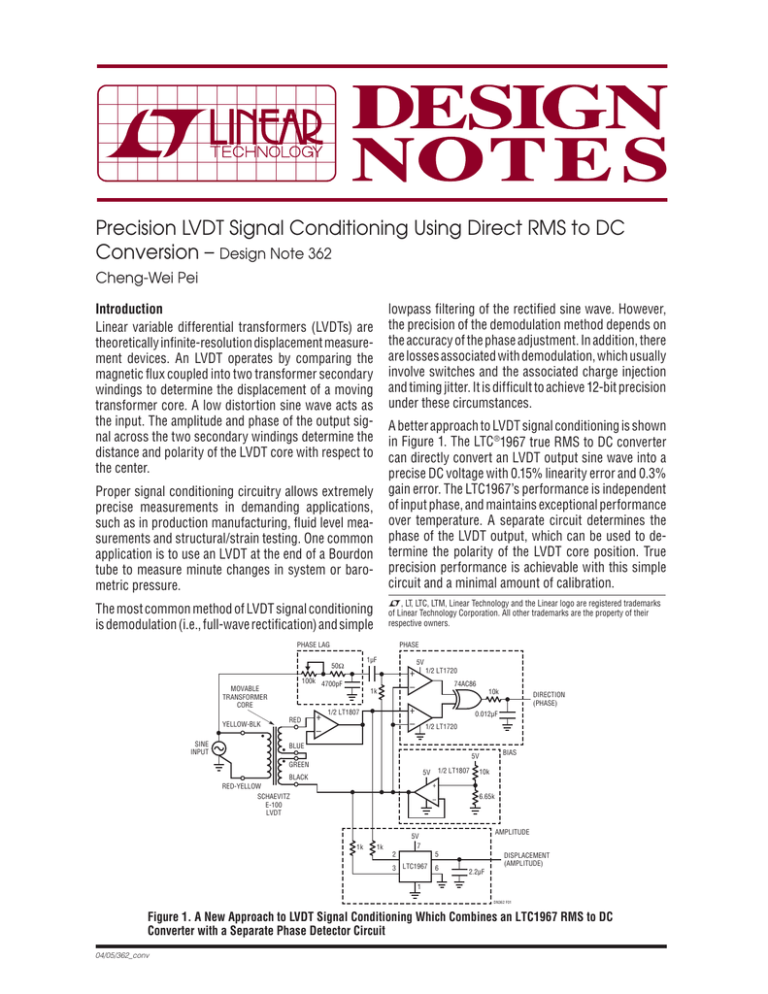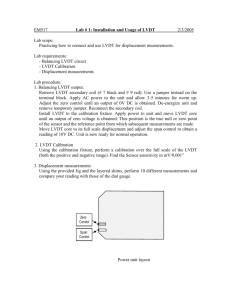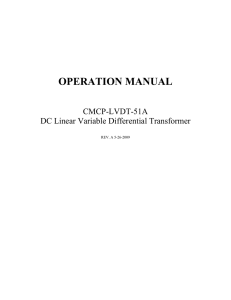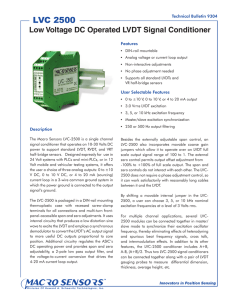DN362 - Precision LVDT Signal Conditioning Using Direct RMS to
advertisement

Precision LVDT Signal Conditioning Using Direct RMS to DC Conversion – Design Note 362 Cheng-Wei Pei lowpass filtering of the rectified sine wave. However, the precision of the demodulation method depends on the accuracy of the phase adjustment. In addition, there are losses associated with demodulation, which usually involve switches and the associated charge injection and timing jitter. It is difficult to achieve 12-bit precision under these circumstances. Introduction Linear variable differential transformers (LVDTs) are theoretically infinite-resolution displacement measurement devices. An LVDT operates by comparing the magnetic flux coupled into two transformer secondary windings to determine the displacement of a moving transformer core. A low distortion sine wave acts as the input. The amplitude and phase of the output signal across the two secondary windings determine the distance and polarity of the LVDT core with respect to the center. Proper signal conditioning circuitry allows extremely precise measurements in demanding applications, such as in production manufacturing, fluid level measurements and structural/strain testing. One common application is to use an LVDT at the end of a Bourdon tube to measure minute changes in system or barometric pressure. A better approach to LVDT signal conditioning is shown in Figure 1. The LTC ®1967 true RMS to DC converter can directly convert an LVDT output sine wave into a precise DC voltage with 0.15% linearity error and 0.3% gain error. The LTC1967’s performance is independent of input phase, and maintains exceptional performance over temperature. A separate circuit determines the phase of the LVDT output, which can be used to determine the polarity of the LVDT core position. True precision performance is achievable with this simple circuit and a minimal amount of calibration. The most common method of LVDT signal conditioning is demodulation (i.e., full-wave rectification) and simple L, LT, LTC, LTM, Linear Technology and the Linear logo are registered trademarks of Linear Technology Corporation. All other trademarks are the property of their respective owners. PHASE LAG PHASE 1μF 50Ω 100k 4700pF MOVABLE TRANSFORMER CORE 1k RED YELLOW-BLK t SINE INPUT 5V t t + – 1/2 LT1720 + – 74AC86 10k + – 1/2 LT1807 DIRECTION (PHASE) 0.012μF 1/2 LT1720 BLUE BIAS 5V GREEN 1/2 LT1807 5V BLACK 10k + RED-YELLOW SCHAEVITZ E-100 LVDT – 1k 6.65k AMPLITUDE 5V 7 1k 2 5 3 LTC1967 6 DISPLACEMENT (AMPLITUDE) 2.2μF 1 DN362 F01 Figure 1. A New Approach to LVDT Signal Conditioning Which Combines an LTC1967 RMS to DC Converter with a Separate Phase Detector Circuit 04/05/362_conv Circuit Description The LVDT shown in Figure 1, a Schaevitz E-100 with ±2.5mm of linear range, is driven by a low distortion, amplitude-stable 3VRMS (the manufacturer’s recommended amplitude) sine wave on the primary windings of the transformer. The frequency, 10kHz, is the maximum recommended for the E-100, though LVDTs exist that work well up to hundreds of kilohertz. Use of higher excitation frequencies with the higher-frequency LTC1968 RMS to DC converter would result in faster settling times and reduced audio-frequency signals that could cause interference. The phase detector portion of the circuit consists of a phase adjustment network (which provides phase lead or lag, depending on the specific LVDT and excitation frequency), an exclusive-OR (XOR) logic gate and an RC lowpass filter network. The circuit output is high when the LVDT core is on one side of center and low when it moves to the other side. Two LT1720 comparators sense the zero-crossing points of the phase-adjusted input and output sine waves. The XOR gate has a low output when the inputs agree and a high output when the inputs disagree. The RC networks limit the Data Sheet Download www.linear.com Linear Technology Corporation Circuit Calibration To calibrate the signal conditioning circuit, first move the LVDT into the null (center) position. The center position is where the amplitude output is at its minimum. Note the output voltage of the phase detector; adjust the phase lead/lag network until the output reaches approximately 2V. Note the amplitude outputs at the extremes which may vary between LVDTs. Conclusion Figure 2 shows the amplitude and phase outputs of the circuit in Figure 1. A novel approach to LVDT signal conditioning yields stable, precise performance and a low IC count. Unlike a synchronous demodulation scheme, the accuracy of the circuit does not hinge on a manual phase adjustment—only on the built-in high precision of the LTC1967 (or LTC1968) true RMS to DC converter. The circuit is robust enough for many industrial and instrumentation applications—it maintains good precision over temperature and it is immune to input signal phase. A separate, easily-calibrated phase detector determines which side of center the LVDT core occupies. 5.0 700 4.5 600 4.0 AMPLITUDE 500 3.5 PHASE 3.0 400 2.5 300 2.0 1.5 200 PHASE OUTPUT (V) To facilitate single supply operation, one-half of an LT®1807 amplifier biases the output sine wave DC level to fall within the common mode range of the measurement circuit (approximately 2V on a 5V supply). The other half of the LT1807 buffers the LVDT output for good signal fidelity. The LT1807 was chosen for its high open-loop gain at 10kHz, extremely low distortion and high common mode rejection to maintain the accuracy of the LVDT amplitude signal. The LT1807’s buffered output signal is converted by an LTC1967 true RMS to DC converter to a DC signal that is linearly proportional to the displacement of the transformer core. bandwidth of the phase network to 1.3kHz in order to limit the effect of comparator output spikes due to slight phase mismatch. It is recommended that the phase detector band-limiting network be lower in frequency than the LVDT excitation frequency, to minimize the phase output ripple. AMPLITUDE (VRMS) LVDT Operation LVDTs are driven by a low distortion sine wave in the primary winding of the transformer. In a 12-bit system, the input sine wave needs less than –74dB distortion and better than 0.02% amplitude stability. In the null (center) position, the two secondary windings receive the same amount of magnetic coupling, but the differential voltage across them is not zero due to the flux leakage of the LVDT (see Figure 2). When the LVDT core moves in one direction or the other, the differential voltage amplitude increases. The phase of the differential output changes depending on which side of center the LVDT core sits. 1.0 100 0.5 0 –3 –2 1 0 –1 DISTANCE (mm) 2 3 0 DN362 F02 Figure 2. Amplitude and Phase Output Versus Position of the LVDT Circuit. The Non-Zero Center Amplitude is Due to Flux Leakage in the LVDT and is Not Caused by the Measurement Circuit For applications help, call (408) 432-1900 dn362f_conv LT/TP 0405 409K • PRINTED IN THE USA 1630 McCarthy Blvd., Milpitas, CA 95035-7417 (408) 432-1900 ● FAX: (408) 434-0507 ● www.linear.com © LINEAR TECHNOLOGY CORPORATION 2005





